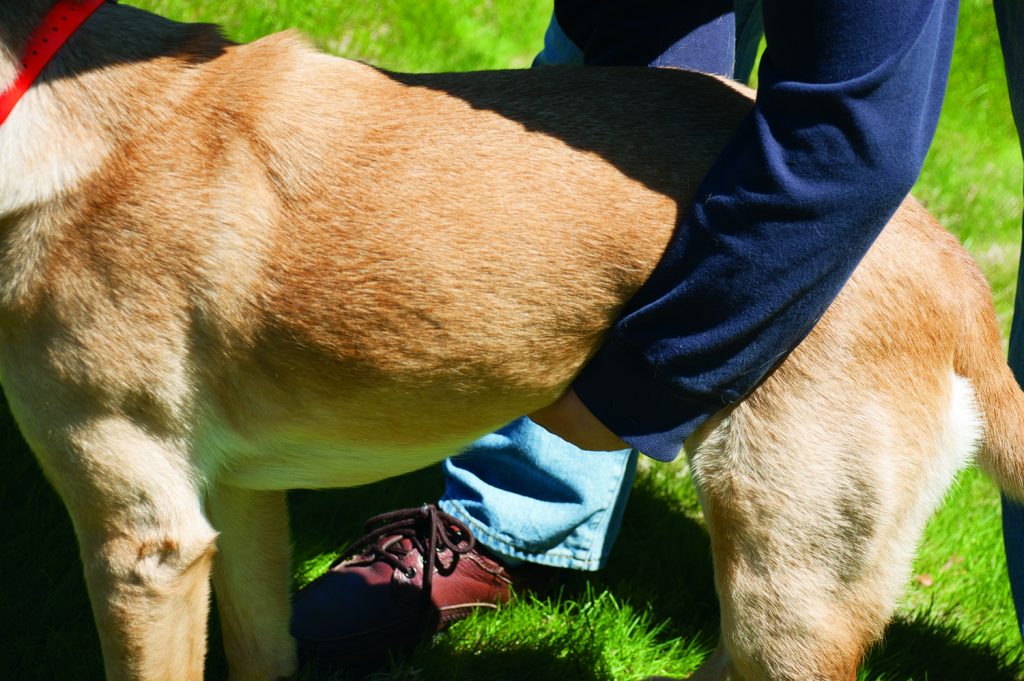by Jillian LaCross
There’s a popular quote attributed to Roger Caras that dog owners know well: “Dogs are not our whole life, but they make our lives whole.” What a beautiful sentiment. Yet, we all know it’s also just one side of the same coin.
As fortunate as we are to have Labs in our lives, our Labs should be just as fortunate to have us. There are many things dogs cannot do for themselves, which means it’s up to us to help them if they get sick or injured, to pay attention to the signs, and to assist with their overall care and healing – and to be able to respond in ways that lead to better outcomes.
Back in the July/August 2013 issue of this publication, we spoke with experts at the American Red Cross about its Pet First Aid Course, which had launched in 2008 and had the overarching goal of better preparing pet owners to handle medical emergencies. Dr. Deborah Mandell, VMD, DACVECC, member of the American Red Cross Scientific Advisory Council, Professor of Emergency and Critical Care Medicine, and Director of Emergency Service at Ryan Veterinary Hospital of the University of Pennsylvania, stated at that time that more than 5,000 people had (up to that point) attended a physical Pet First Aid Course, specializing in either dogs or cats.
Are those classes still available? “The American Red Cross no longer offers in-person Pet First Aid courses,” explains Dr. Mandell. “Our online Cat and Dog First Aid course (www.redcross.org/petfirstaid) is available for pet owners and caretakers.” This course launched nearly a decade ago. Information is also disseminated through an app – Pet First Aid – which is made available for both for iOS and Android.
“In the past ten years, nearly 50,000 people have taken a Red Cross Pet First Aid course, and that number has grown every year,” reports Dr. Mandell.
New Resources

The app is a handy resource since our smartphones are always on hand. It’s well-organized around five primary areas: Learn, Prepare, Emergency, Quizzes, and Pets.
The “Learn” section is where you can find an alphabetical list of health problems and how to manage them. With this information, you can better respond and better ensure that your Lab is protected from further harm, injury, or suffering until he reaches veterinary care. In “Choking” for example, listed are the signs that your dog may be choking and a five-step list of what to do. There are also related links, such as to CPR (see sidebar), and FAQs related to that specific topic. The online course walks you through a few situations you may encounter, such as serious wounds that require pressure and bandaging, cleaning out shallow wounds, what to look for after a bite encounter, what to do during a seizure, and how to handle wounds to your Lab’s paw pads.
The “Prepare” section of the app features a hotel locator, vet clinic locator, and preparedness tips for a wide range of topics from personal travel to end of life care. “Quizzes” help owners test their retention. The “Pets” section is where owners can provide personal information on each of their pets, such as medical history and current medications. This can be useful in stressful situations or if you find yourself at an unfamiliar vet clinic (you don’t have to try to recall anything, and chances are your phone is on you).
The app, of course, is free. If you take the online course, it costs $25 and takes about 30 minutes. As an attendee, you work your way through a few different sections. There is some interactivity and visuals, in addition to solid, professional-grade information. At the end of each section is a quiz that provides immediate feedback. “Upon successful completion of all the lessons and a concluding assessment, users can print out a certificate attesting to their new knowledge,” explains Dr. Mandell.
Baseline
Although the app makes it easy to have information at your fingertips and the course takes only a little part of your day to complete, these tools can only be used at their best if you are an attentive and knowledgeable owner.
At the top of the “Learn” section in the app, and the lead-off for the online course, is “Know What’s Normal.” As written in the earlier article, “Owners are responsible for being aware of any changes to their Lab’s appearance or behavior, and to be proactive should an emergency occur. Every Lab is different and owners need to be conscious of what is typical for their Lab.” Your Lab is an individual and has “normal” behavior as well as a unique health profile, such as allergies or heart disease, which carry their own risks and potential associated medical emergencies.
“For instance, if your dog is a diabetic and is showing signs of too low blood sugar, rub molasses or corn syrup on the gums to try to increase the blood sugar,” explained Dr. Mandell back in 2013.
Dogs have baseline vital signs that will help you better identify a problem and its potential cause. In the online course, participants learn about what constitutes (for dogs) a normal breathing rate, capillary refill time, body temperature, heart rate, and what a healthy mucus membrane looks like (and doesn’t). Understanding the baseline before an emergency occurs is essential for your response and your Lab’s health.
According to Dr. Mandell in that original lifesaving article: “Understanding how to take care of your dog to keep him healthy may prevent problems in the future. Your dog, and especially Labradors, just want to make you happy and will wag his tail no matter how bad he is feeling. We have to be able to recognize that there may be a problem despite this. Knowing [your dog’s] normal gum color, respiratory rate, heart/pulse rate, capillary refill time, temperature, attitude, activity, appetite, etcetera, will be extremely important if you run into an emergency situation or are unsure if you have an emergency.”
You don’t want to be comparing notes in a high-stress moment, wondering what’s normal. Review baseline information through the American Red Cross Tools and run through a physical exam of your Lab a few times so that you gain some experience while your Lab is healthy. And, as always, trust your gut if you suspect something is amiss.
Being Prepared – and Responding – in a Digital Age
Knowledge is power. In addition to going through training for more complex medical emergencies, it’s important to be prepared in other basic ways. As the American Red Cross app and online course strongly encourage, your Lab should have identification on their collar at all times, you should know your vet’s number or know where to find the nearest vet if you’re in a location other than home (the Pet First Aid app has this capability), and have an emergency kit at the ready if you are away. An emergency kit should include an extra leash, some food, portable bowls, water, copies of medical records, a first aid kit, a current photo of your Lab, and information such as feeding schedule, medical conditions, and any behavior issues unique to your Lab.
You won’t always know what to do when your Lab encounters a problem. And even though our smartphones are really handy in helping us figure it out, it’s important to use reliable information. “The internet and social media have made information more accessible than ever, which can be a double-edged sword, especially in emergencies. Pet owners now turn to their phones instinctively, but the challenge is knowing which sources are credible,” explains Dr. Mandell. “That’s why organizations like the Red Cross are so important. We provide training and resources that are grounded in expert knowledge and designed to help people respond effectively and safely. In a crisis, you want to be confident that the information you’re using is accurate, not just popular or trending. Online non-medical or non-veterinary resources can also lead to a false sense of security, delaying veterinary care when it is needed.”
Look at your lovable, devoted Lab. You would do practically anything to ensure he has a healthy, long life and wouldn’t want to endanger him further by wasting time scrolling. Taking a specialized pet course through the American Red Cross helps to prepare you with the knowledge and skills you might need to use to personally treat your Lab or better understand that veterinary care is needed pronto. The app is a handy tool that could become an imperative part of your dog ownership journey, offering dependable information when you need it most.
“Smartphones give us instant access to information, but in a crisis, speed and reliability matter. The Red Cross Pet First Aid app was developed to have everything you need right in one place. It has separate dog and cat tabs and goes through a wide range of topics to help owners and caregivers, including how to recognize and what to do in many types of emergencies,” says Dr. Mandell. “The online Red Cross Pet First Aid course complements the app with an easy and convenient way to learn lifesaving skills for pets at their own pace. Most people are used to having apps on their phones for everything now, and the Red Cross Pet First Aid app is one that we believe is essential to all pet owners.”
ABCs and CPR
Some events can be terribly scary and time-sensitive, so it’s important to follow the ABCs and know how to perform CPR on your Lab. What are the ABCs?
Check Airway: Look for an obstruction that could be causing the issue. Try to remove the object by swiping it away if possible, otherwise, use abdominal thrusts. Time is of the essence, because if there is nothing to remove, you need to move on to Breathing and Circulation.
Check Breathing: Check for breathing – fast, slow, non-existent?
Check Circulation: Check for a pulse. If not found within 15 seconds, begin CPR and continue until you reach the vet.
Canine CPR is similar to human CPR. According to the online course, “Place one hand over the other, with the heel of the hand should be placed on the highest or widest part of the chest [just below the elbow]. Lock the elbows, your shoulders should be above the hands. Compress 1/3 to 1/2 the width of the chest. Make sure the chest fully recoils before compressing again. Perform chest compressions at a rate of 100-120 per minute. Gently close the pet’s mouth and extend the neck to open the airway. Cover the nose with your mouth and exhale until you see the pet’s chest rise. Give two breaths after every 30 compressions.”
Performing Abdominal Thrusts on a Conscious Dog When an Object is Lodged
Always use caution when examining a conscious animal and be careful not to push the object farther down the throat. If you cannot see or remove the object, perform abdominal thrusts:

Technique 1
- Lift the front end of the dog up, spine against you, and wrap your arms around the dog under the ribs.
- Make a fist with one hand and wrap your other hand around the fist.
- Give five rapid inward and upward thrusts.
- Check the dog’s mouth to see if you can see the object to remove.
- If this is unsuccessful, give five sharp back blows between the shoulder blades using the palm of your hand.
- Check the mouth for the object (if it didn’t come out) and remove it.
Technique 2
- Stand over the dog with your legs over his hind legs.
- Wrap your hands around him under the ribs.
- Perform five abdominal thrusts inward and upward.
- Check the dog’s mouth to see if you can see the object to remove.
- If this is unsuccessful, give five sharp back blows between the shoulder blades using the palm of your hand.
- Check the mouth for the object (if it didn’t come out) and remove it.
Technique 3
- If the dog is lying down and you cannot lift him, place the head and neck in a neutral position.
- Place the palms of your hands under the ribs.
- Give five rapid abdominal thrusts inward and upward.
- Check the dog’s mouth to see if you can see the object to remove.
- If this is unsuccessful, give five sharp back blows between the shoulder blades using the palm of your hand.
- Check the mouth for the object (if it didn’t come out) and remove it.
(Note: If the dog is unconscious, pull the tongue forward and try to remove the object or foreign material.) If the dog is not breathing on its own, start rescue breaths (explained in this article but also always available through the app).




